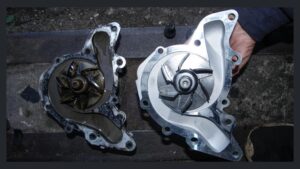
4 Symptoms of a Failed Water Pump
Internal combustion engines generate an immense amount of heat. After all, thousands of tiny explosions occur inside the engine every minute. This heat requires an efficient cooling system, and the water pump is the heart of any liquid cooling system.
The function of the water pump is to keep coolant flowing from the radiator to the engine. As long as the water pump is functioning properly, coolant will keep flowing as intended and your engine will stay cool. If your water pump has an issue that affects its ability to flow coolant, it can cause serious problems with your engine.
What does a car’s water pump do? The water pump circulates coolant (or “water”) throughout the engine. Water pumps are usually driven by the timing belt, although some water pumps are driven by a V-belt pulley instead.
The water pump is usually not visible without removing a few parts from the engine bay. Which parts you need to remove will vary depending on your vehicle. Some water pumps are hidden under a timing cover that protects the camshaft gears.
When you open the hood, you’ll often see a belt-driven water pump. These water pumps are usually easier to replace because they require less engine disassembly.
Symptoms of a Broken Water Pump
Whether it’s a car or truck, your vehicle’s water pump needs to last a long time. However, that doesn’t mean that your water pump won’t wear out after a while. Once it does, you’ll start to see obvious symptoms.
These symptoms shouldn’t be ignored, as not replacing your water pump right away can cause permanent damage to vital components in your car’s engine. Replacing a broken water pump is much cheaper than repairing a catastrophic engine failure, so take this seriously. Here are the main symptoms of a failing water pump:
1) Engine overheating
The water pump pumps coolant into the engine to keep it cool, so if the water pump isn’t working properly, your engine will obviously overheat.
The temperature gauge on your dashboard should tell you that your engine is overheating. At this point, you should check the water pump and other cooling system components.
2) Coolant leaks
The water pump has numerous seals and seal rings that are responsible for keeping the coolant in the pump. Instead, the coolant will leak from the pump and spill onto the floor. You should see coolant on the ground under the center of the car and near the front of the car. This is definitely a problem you want to solve right away.
3) Steam in the Radiator
If you’re driving your car and see steam coming out of the hood, this is a clear sign that your engine is overheating. You’ll only get to this point if you ignored previous warning signs of an overheating engine, like a temperature gauge or coolant leaks. In this situation, if you don’t take your car to a repair shop right away, your engine could break down at any time. Even if your vehicle is still running, it’s better to have it towed to a workshop. You don’t want to take the risk.
4) Howling noise
The water pump assembly is equipped with bearings that are essential to keep it functioning. If these bearings no longer function properly, the belt in the assembly will loosen. A loose belt will make a whistling or humming noise as the pump tries to circulate the coolant. You should hear a strange noise coming from the front of the car.
What does a faulty water pump sound like?
A broken water pump may not make any strange noises. Some water pumps fail because coolant leaks out of the drain hole. Some fail due to a broken pulley or a clogged impeller. A mechanically defective water pump can cause a whistling or grinding noise.

